Drosera micrantha Lehm.
The epithet micrantha is derived from the Greek micros (small) and anthos (flower), referring to the small flowers of this species.
Drosera micrantha is known from Western Australia. It is relatively common and widely distributed from Perth to Albany.
It grows in white silica sand soils on the margins of swamps on higher ground; in similar soils scattered throughout Banksia menziesii woodlands; in the Darling Range region east of Perth, but only in deep silica sand areas.
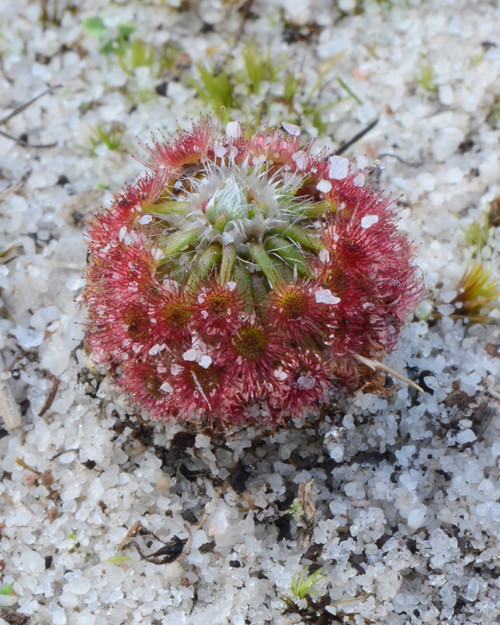
Drosera micrantha. Photo © Richard Nunn.
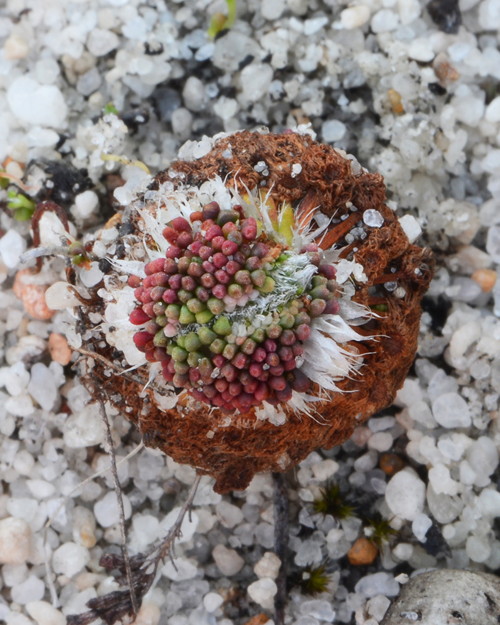
Drosera micrantha. Photo © Richard Nunn.
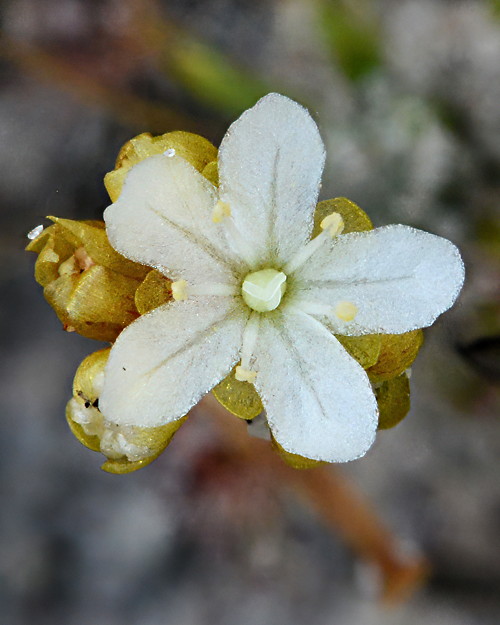
Drosera micrantha. Photo © Richard Nunn.
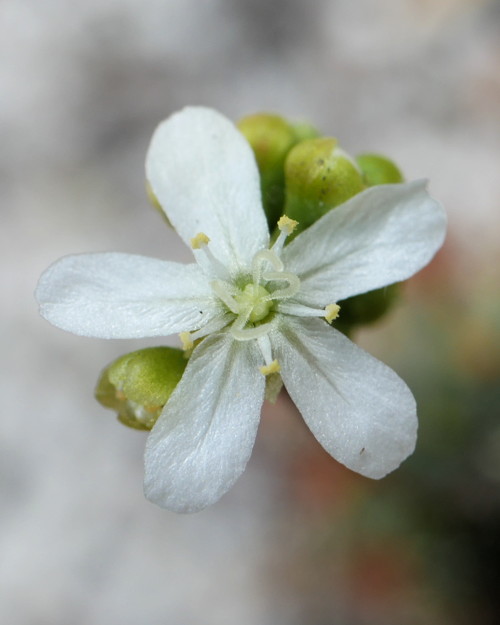
Drosera micrantha. Photo © Thilo Krueger.
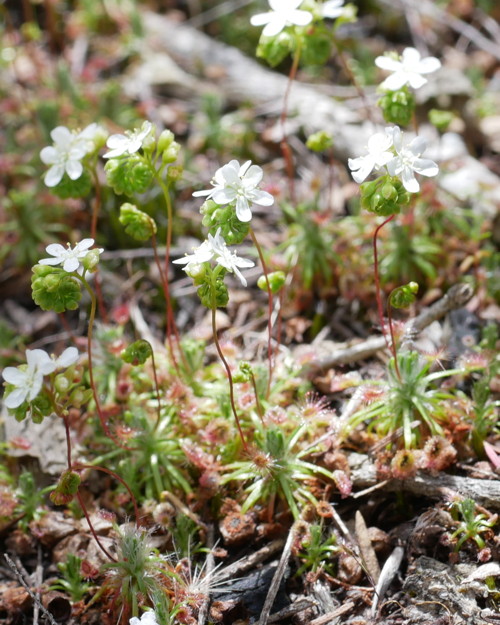
Drosera micrantha. Photo © Thilo Krueger.
Drosera microscapa Debbert
The epithet microscapa is derived from the Greek micros (small) and the Latin scapus (flower stalk), in reference to the short, 1-flowered peduncles of this species.
Drosera microscapa is known from Western Australia, with records from Denmark, Hortons, Manypeaks and Frenchmans Bay.
It grows in black silty sand soils in seepage areas of swamp heathland.
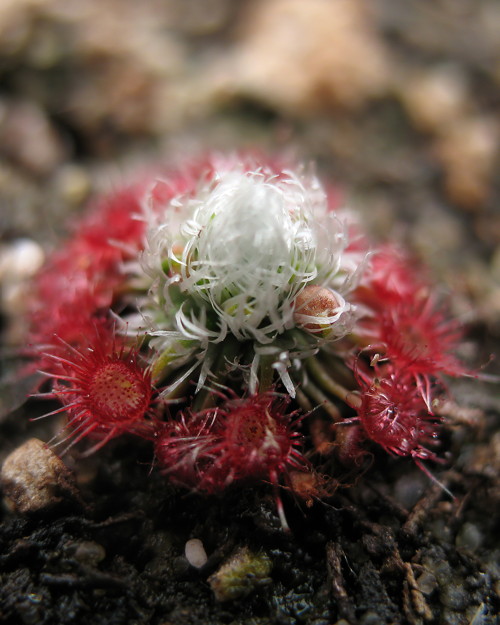
Drosera microscapa. Photo © Steve Fretwell.
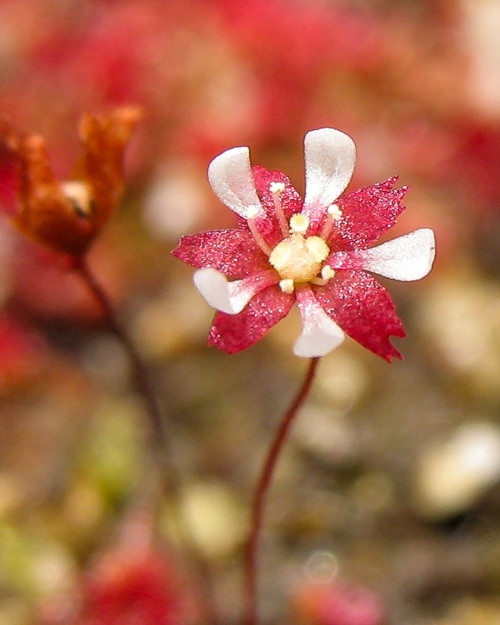
Drosera microscapa. Photo © Steve Fretwell.
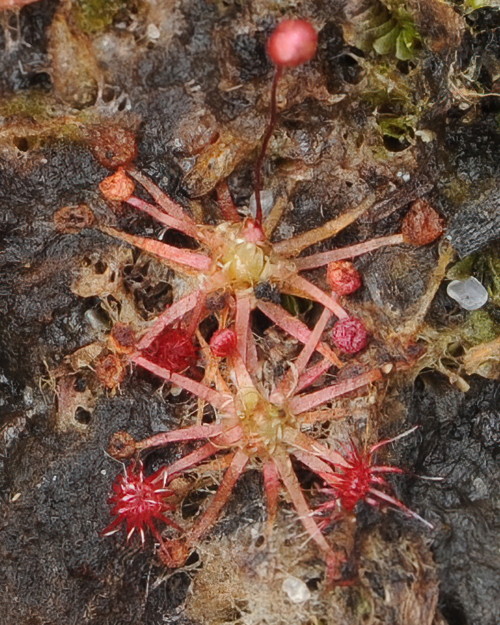
Drosera microscapa. Photo © Richard Nunn.
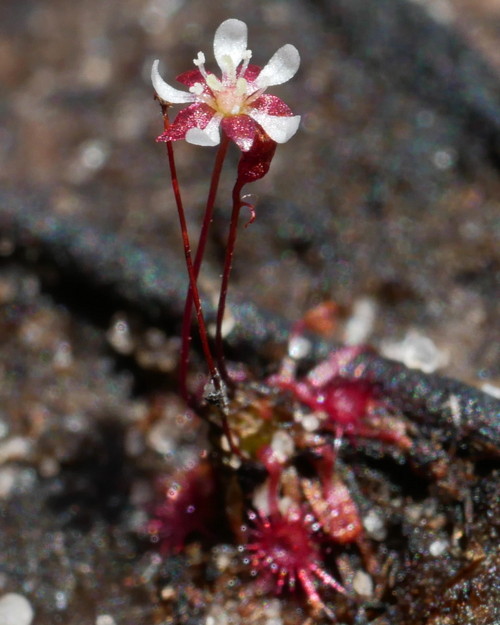
Drosera microscapa. Photo © Thilo Krueger.
Drosera miniata Diels
The epithet miniata is from the Latin miniatus (cinnabar red), referring to the flowers of this species, which are of a reddish orange similar to that of cinnabar, better known as the toxic compound mercury sulphide.
Drosera miniata is known from Western Australia, with records from Gidgegannup, Toodyay and York.
It grows in laterite and clay soils, or loam washes on the aprons of granite outcrops in open forest, scrubland or heath.
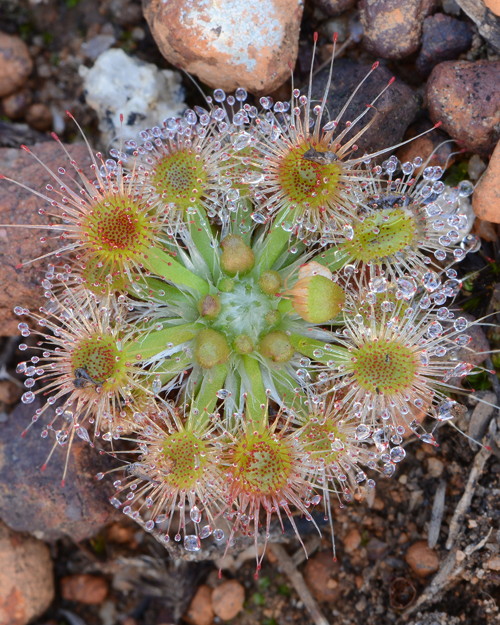
Drosera miniata. Photo © Richard Nunn.
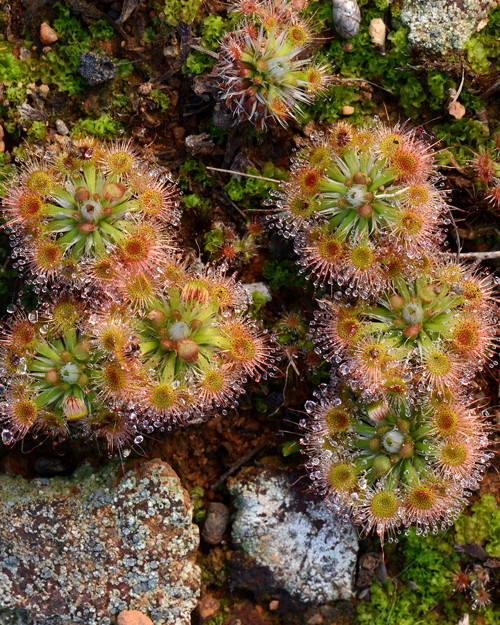
Drosera miniata. Photo © Richard Nunn.
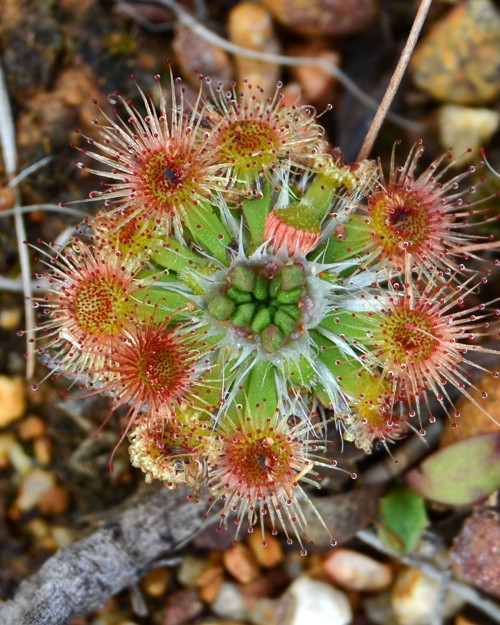
Drosera miniata. Photo © Thilo Krueger.
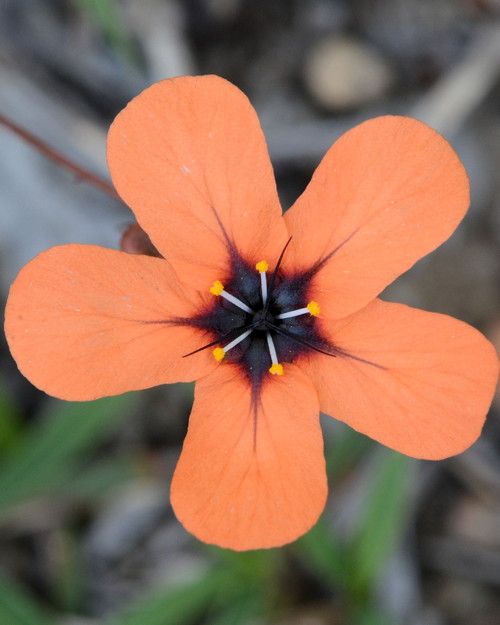
Drosera miniata. Photo © Richard Nunn.
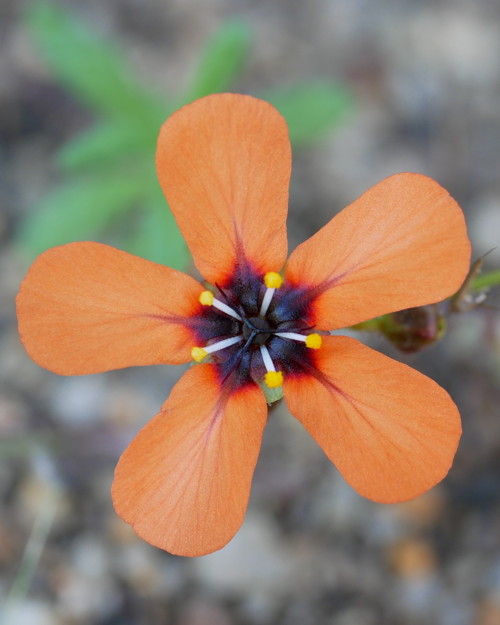
Drosera miniata. Photo © Thilo Krueger.
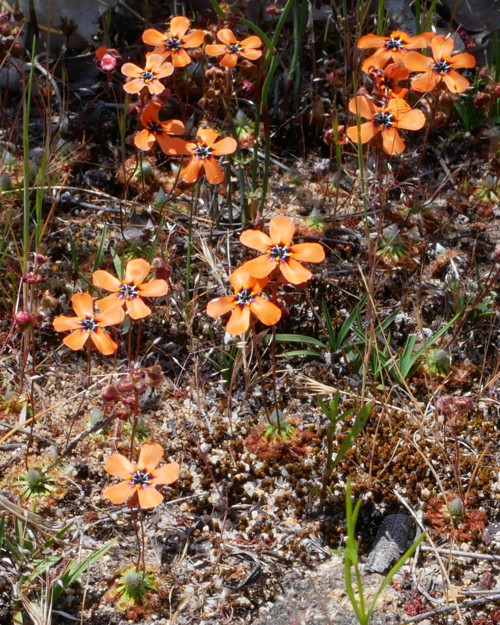
Drosera miniata. Photo © Thilo Krueger.
Drosera minutiflora Planch.
The epithet minutiflora is derived from the Latin minutus (very small) and flora (flower), in reference to its small flowers.
Drosera minutiflora is known from Western Australia, with records from Cataby, Mogumber, Wanneroo, Gnangarra and The Lakes.
It grows in deep, white, silica sand soils between and under low shrubs on heathland.
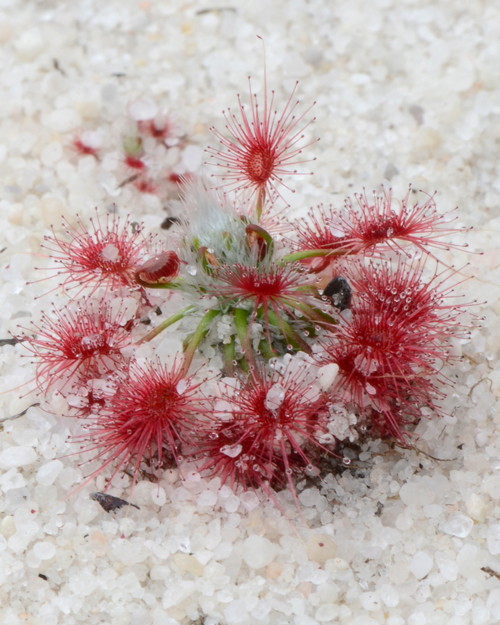
Drosera minutiflora. Photo © Richard Nunn.
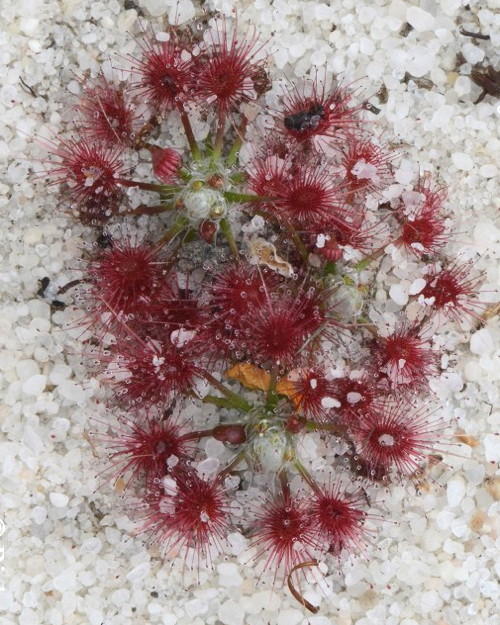
Drosera minutiflora. Photo © Richard Nunn.
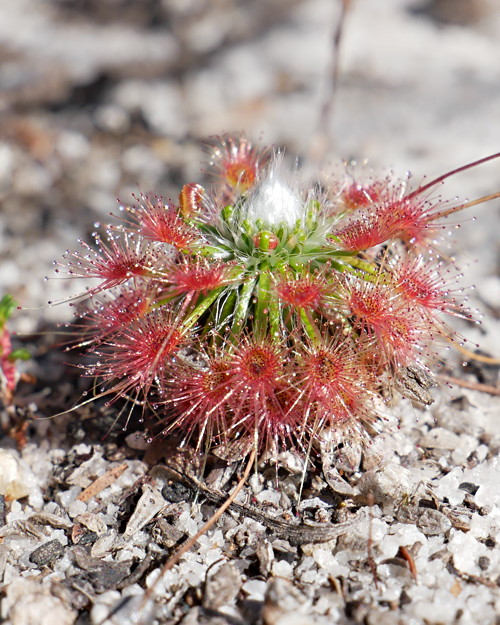
Drosera minutiflora. Photo © Thilo Krueger.
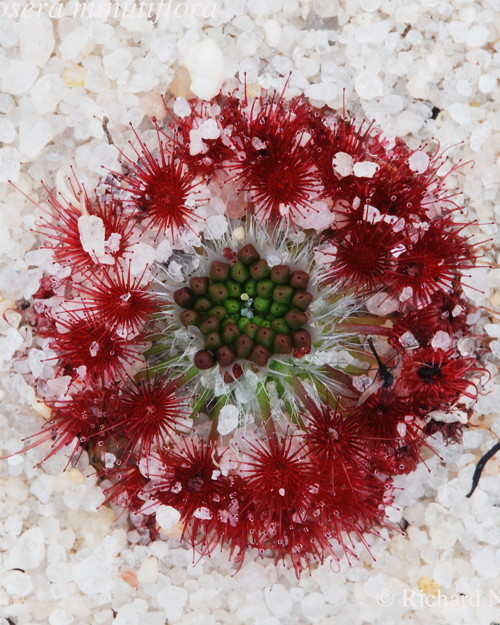
Drosera minutiflora. Photo © Richard Nunn.
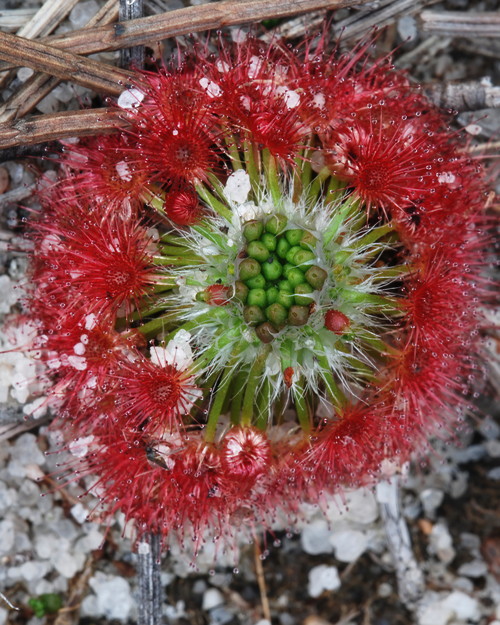
Drosera minutiflora. Photo © Richard Nunn.
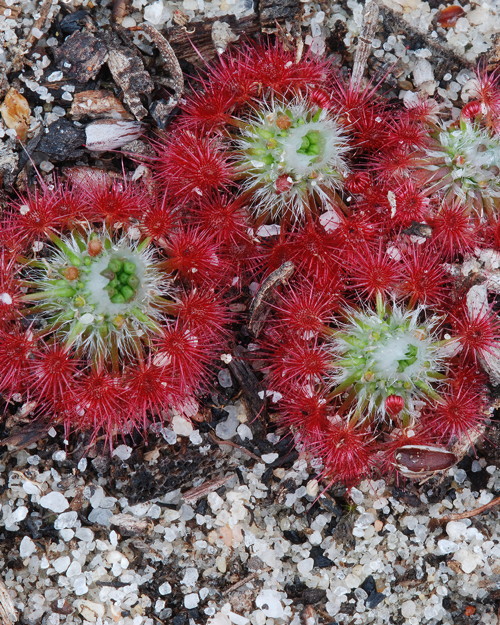
Drosera minutiflora. Photo © Richard Nunn.
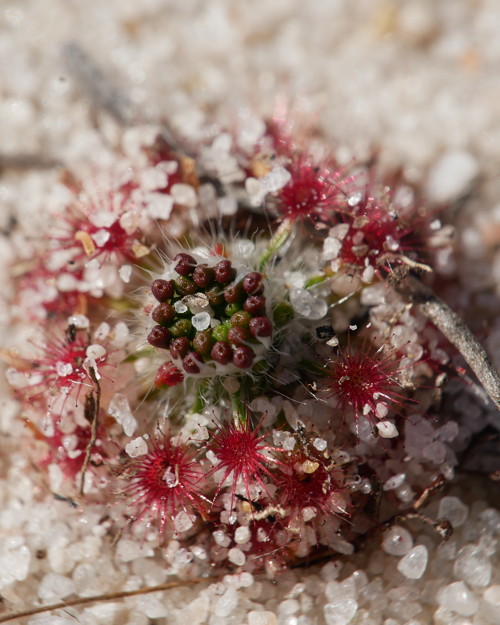
Drosera minutiflora. Photo © Thilo Krueger.
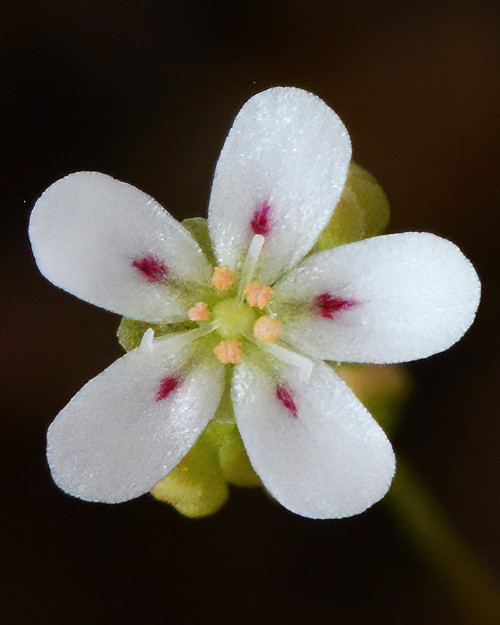
Drosera minutiflora. Photo © Richard Nunn.
Drosera nitidula Planch.
The epithet nitidula is derived from the Latin nitidus (having a shiny surface). It is unclear which morphological character Planchon was referring to, but he may have been referencing the shiny, metallic white petals.
Drosera nitidula is known from Western Australia, with widespread records from Bullsbrook and throughout the woodlands east of Perth, south to Augusta and east to Cape Le Grand, near Esperance, in coastal and near coastal areas.
It grows in clayey sand soils in and on the margins of winter-wet depressions and swamps.
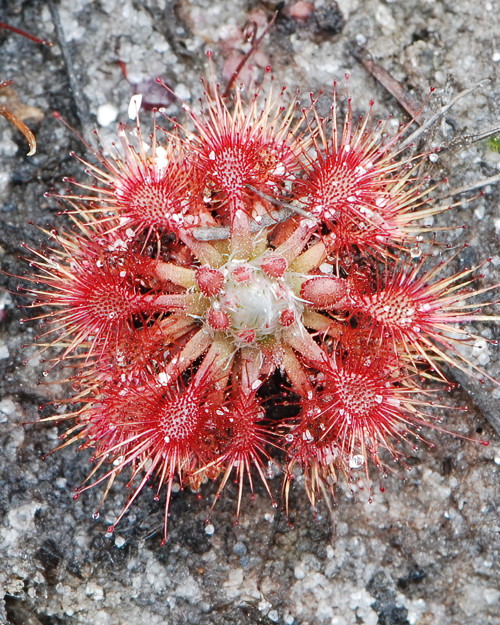
Drosera nitidula. Photo © Richard Nunn.
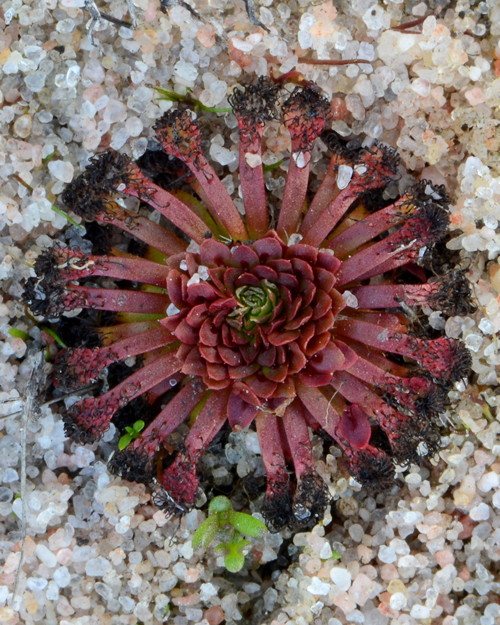
Drosera nitidula. Photo © Richard Nunn.
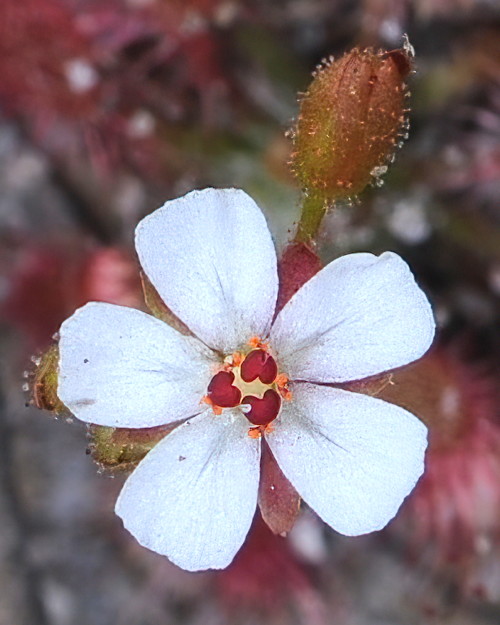
Drosera nitidula. Photo © Richard Nunn.
Drosera nivea Lowrie & Carlquist
The epithet nivea is derived from the Latin niveus (snowy white), in reference to its bright-white flower.
Drosera nivea is known from Western Australia, where it is recorded from the area around Coorow.
It grows in deep, pale yellow and beige sands on heathland beneath and between low shrubs on the sand plains.
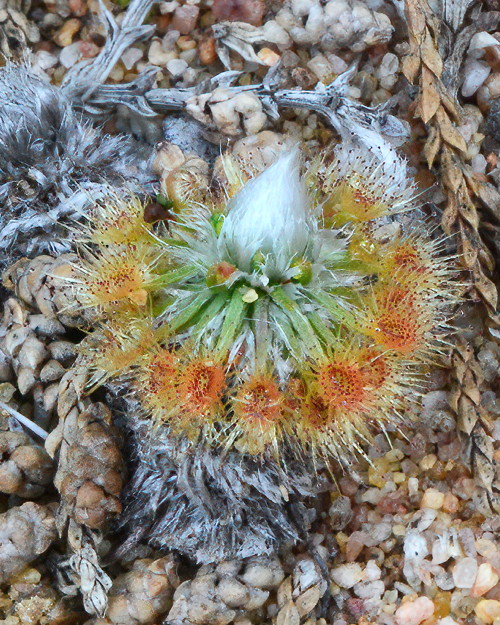
Drosera nivea. Photo © Richard Nunn.
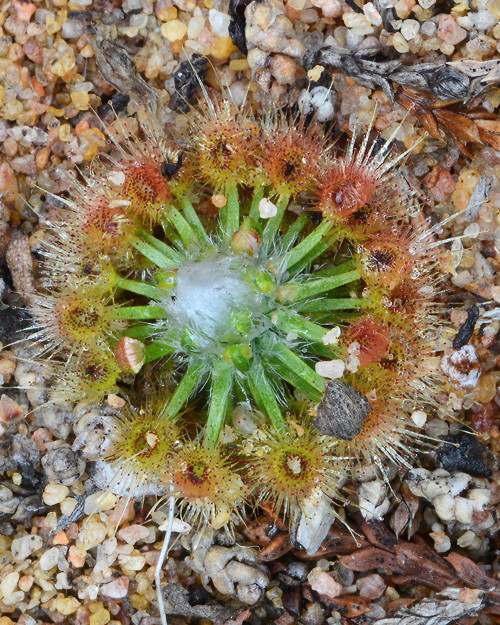
Drosera nivea. Photo © Richard Nunn.
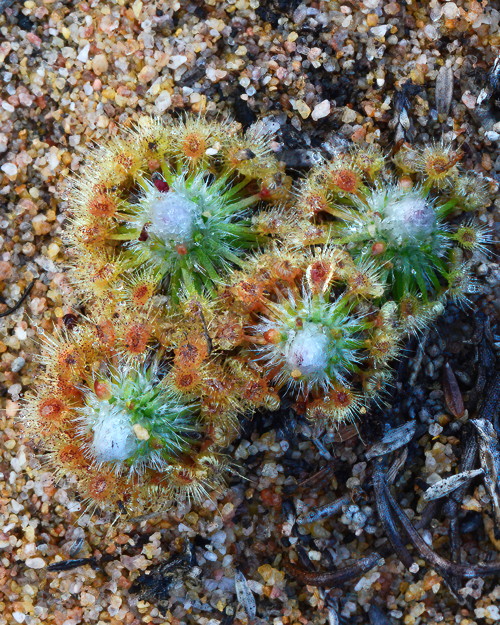
Drosera nivea. Photo © Richard Nunn.
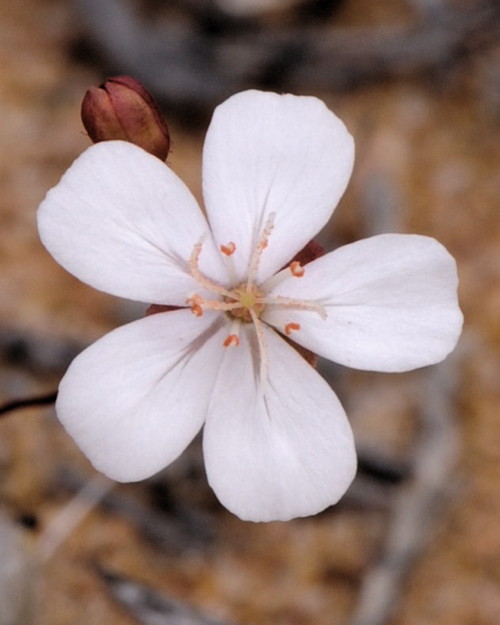
Drosera nivea. Photo © Richard Nunn.
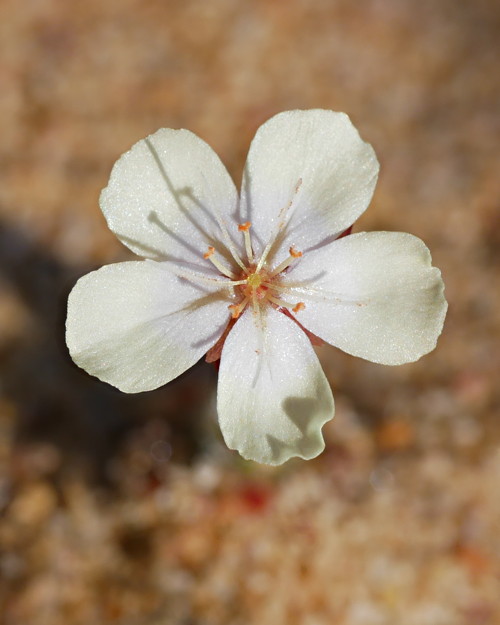
Drosera nivea. Photo © Thilo Krueger.
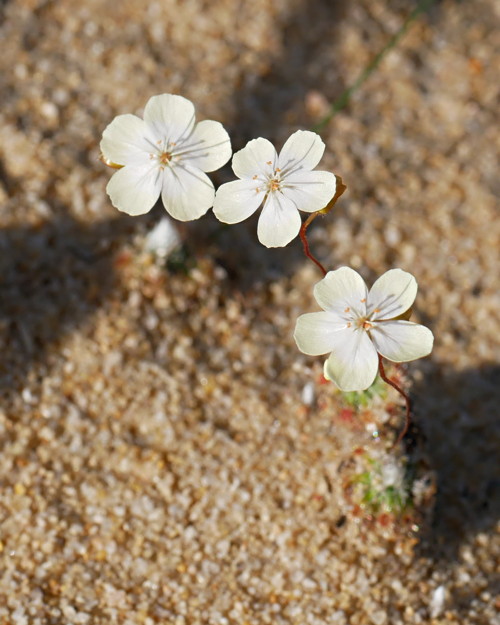
Drosera nivea. Photo © Thilo Krueger.
Drosera occidentalis Morrison
The epithet occidentalis is derived from the Latin occidentalis (western), in reference to this species’ distribution in the western region of Australia.
Drosera occidentalis is known from Western Australia, with records from Gingin, Bullsbrook, Perth, Pinjarra and Carbarup.
It grows in peaty sand around the margins of swamps, winter-wet depressions and watersheds in open areas.
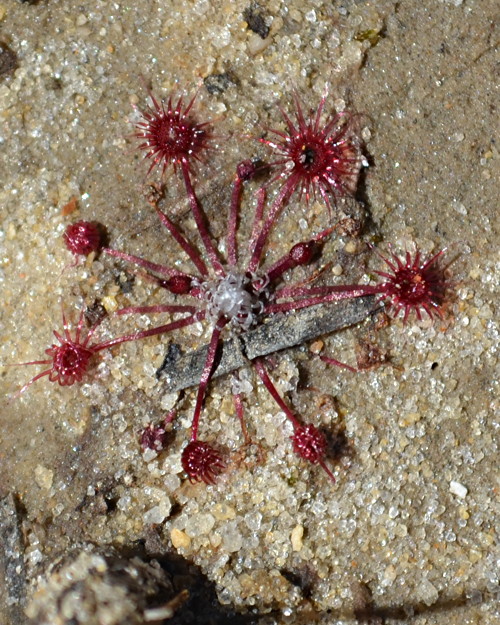
Drosera occidentalis. Photo © Thilo Krueger.
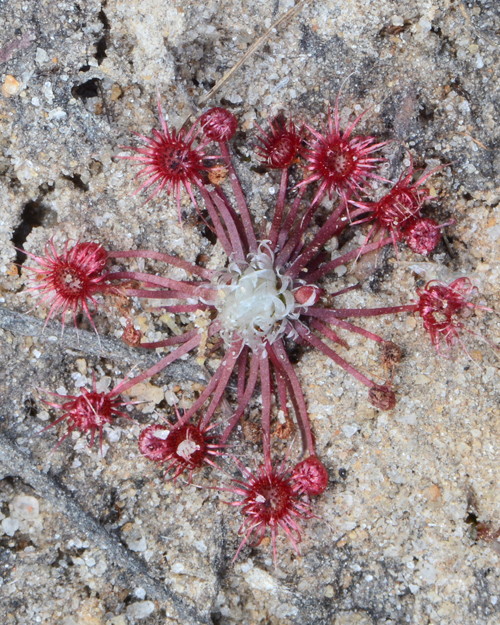
Drosera occidentalis. Photo © Richard Nunn.
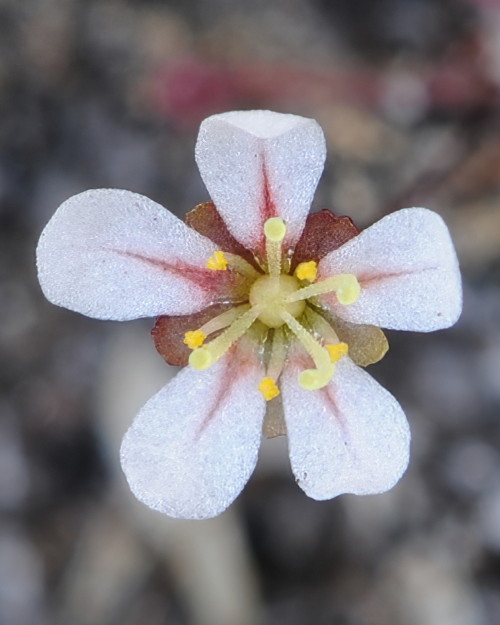
Drosera occidentalis. Photo © Richard Nunn.
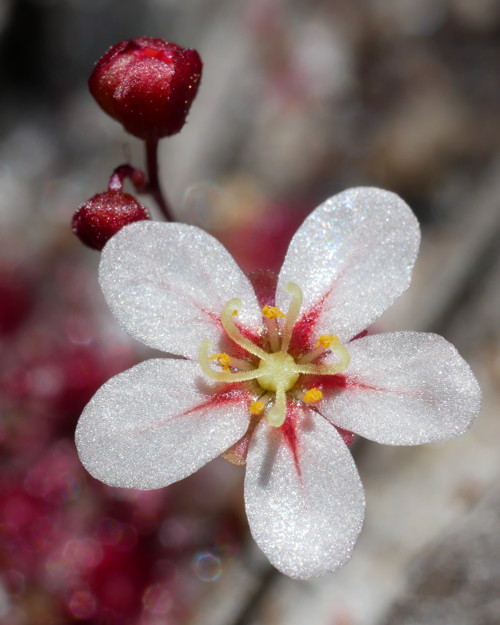
Drosera occidentalis. Photo © Thilo Krueger.
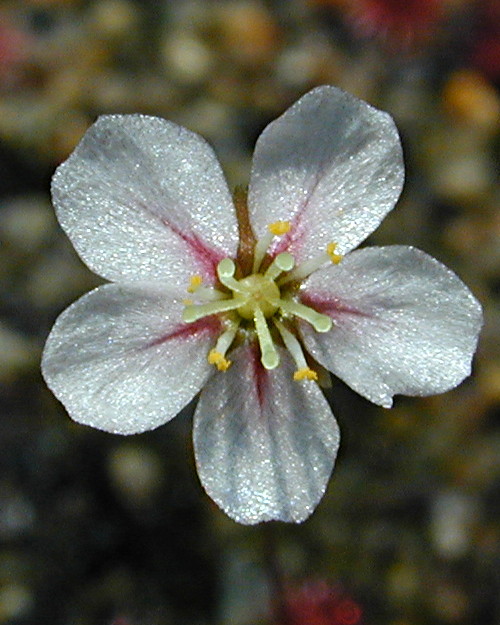
Drosera occidentalis. Photo by John Brittnacher.
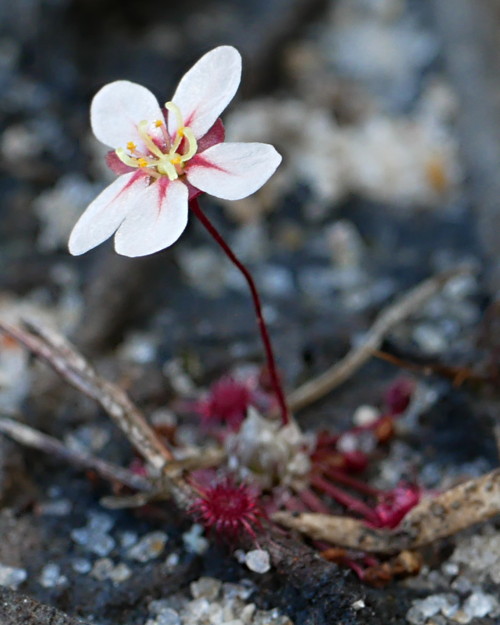
Drosera occidentalis. Photo © Thilo Krueger.
Drosera omissa Diels
The epithet omissa is derived from the Latin omissus (neglected), apparently in reference to Diels himself. Diels previously determined this Drummond collection from Melbourne Herbarium, in his own writing on type sheet No. 7775, to be Drosera nitidula Planchon, later recognizing it as a distinct taxon. Drosera ericksoniae is a synonym of Drosera omissa.
Drosera omissa is known from Western Australia, with records from Kalbarri, Strawberry, Eneabba, Cataby, Pingelly and Ravensthorpe.
It grows in deep white sand around the margins of winter-wet depressions. It has also been found in laterite soils.
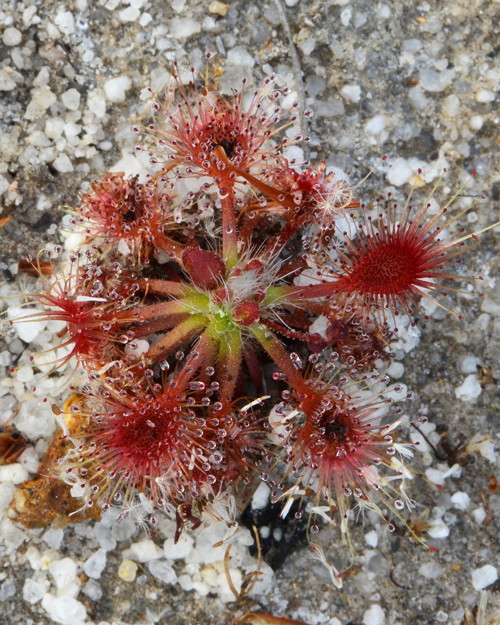
Drosera omissa. Photo © Richard Nunn.
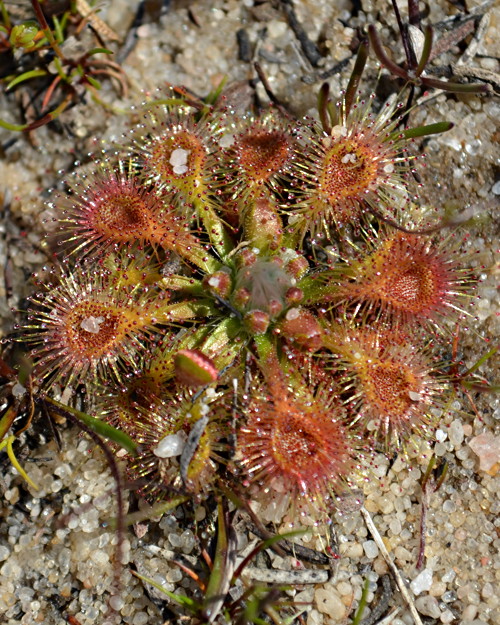
Drosera omissa. Photo © Thilo Krueger.
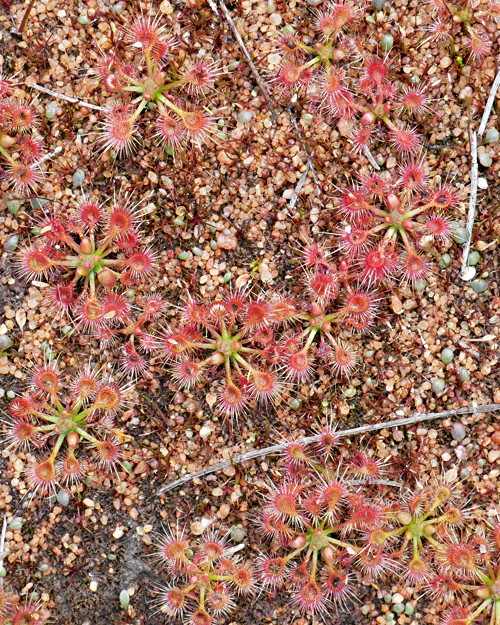
Drosera omissa. Photo © Thilo Krueger.
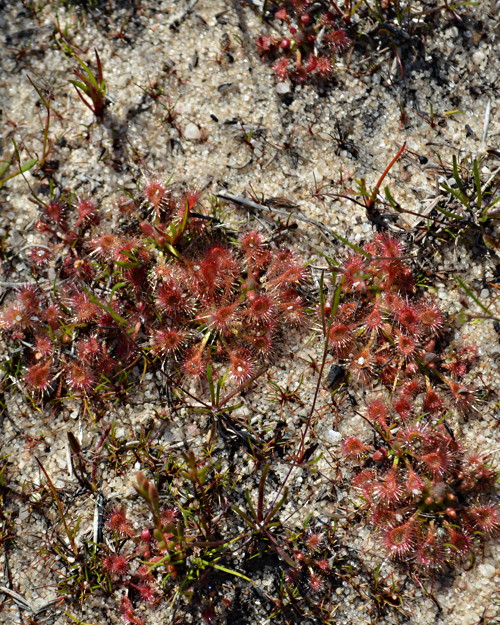
Drosera omissa. Photo © Thilo Krueger.
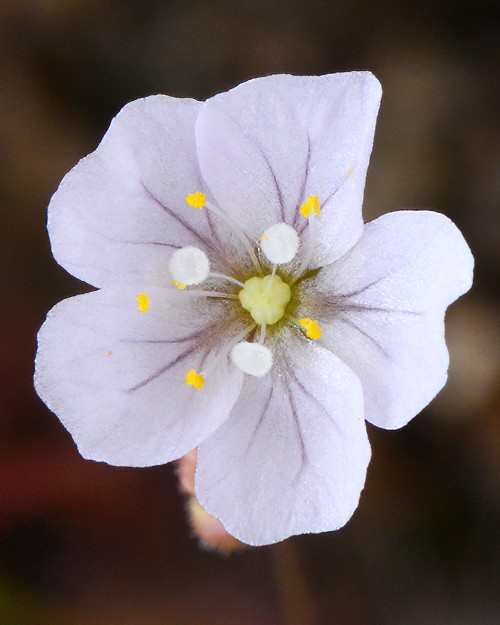
Drosera omissa. Photo © Richard Nunn.
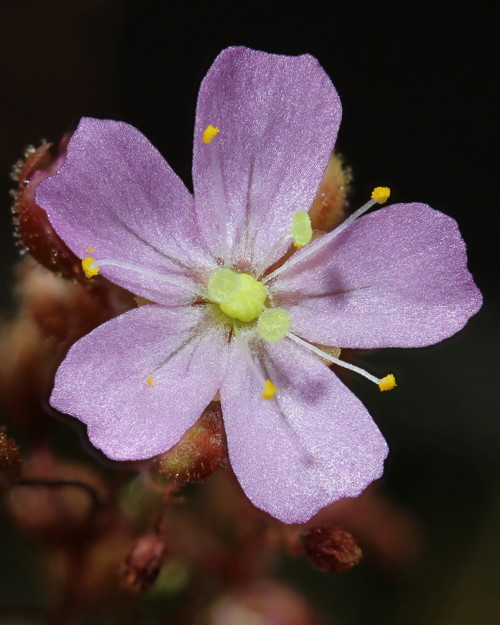
Drosera omissa. Photo by John Brittnacher.
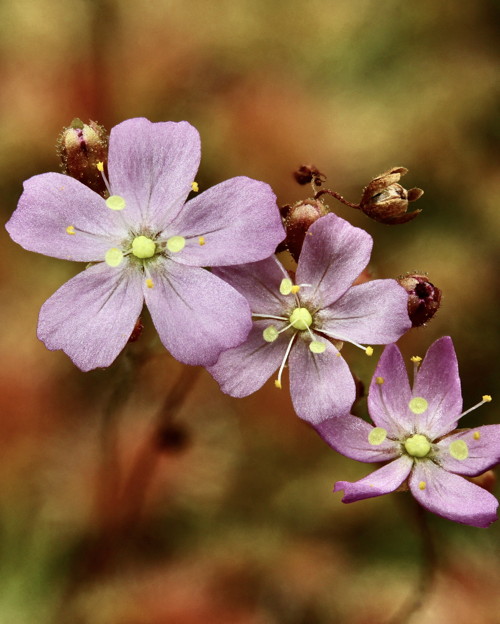
Drosera omissa. Photo by John Brittnacher.
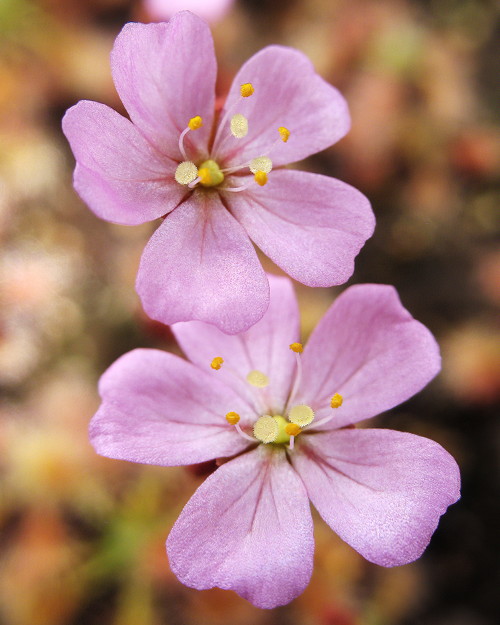
Drosera omissa. Photo © Steve Fretwell.
Drosera oreopodion N.G.Marchant & Lowrie
Drosera oreopodion is named from the Greek oreo (mountain) and podion (foot), in reference to the base of the Darling Range, where this species grows.
Drosera oreopodion is named from the Greek oreo (mountain) and podion (foot), in reference to the base of the Darling Range, where this species grows.
It grows in sandy clay mixed with laterite pebbles on low heathland.
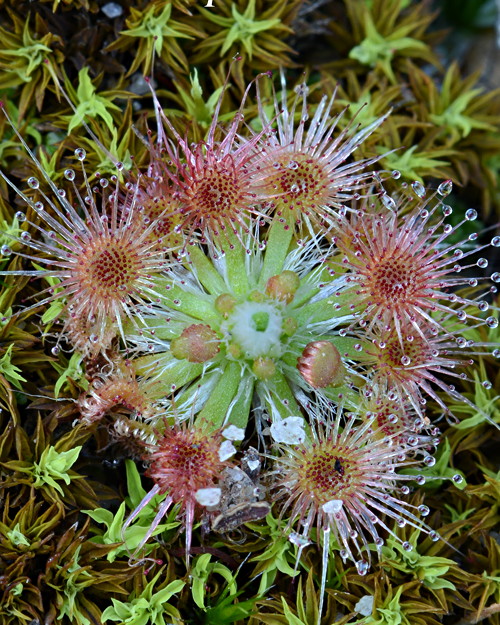
Drosera oreopodion. Photo © Richard Nunn.
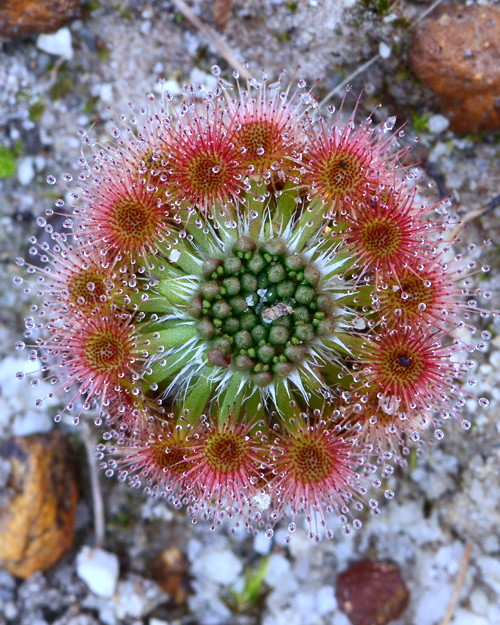
Drosera oreopodion. Photo © Richard Nunn.
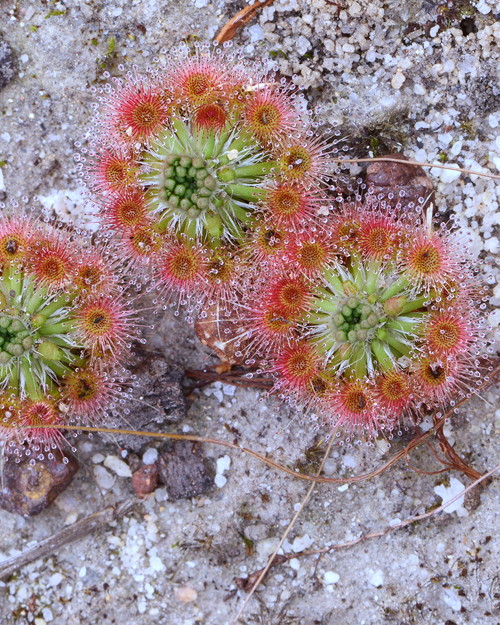
Drosera oreopodion. Photo © Richard Nunn.
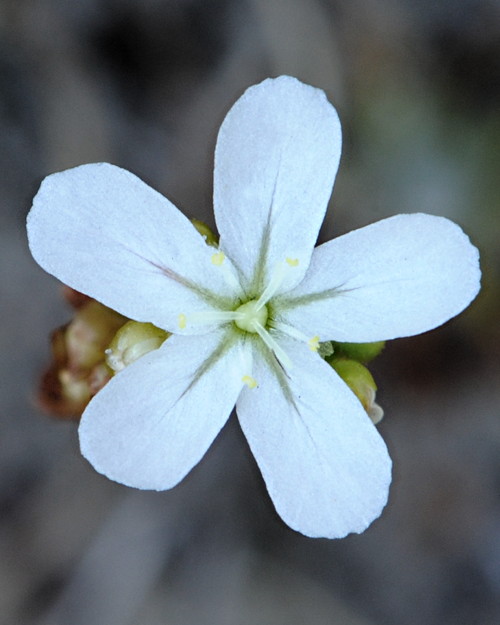
Drosera oreopodion. Photo © Richard Nunn.
Drosera paleacea DC.
Drosera paleacea is named from the Latin paleaceus (with a chaff-like texture), in reference to its scarious stipules.
Drosera paleacea is known from Western Australia, with records from the Albany region, including Lake Sepping, Princess Royal Harbour, Frenchman Bay and Little Grove.
It grows in dense shrub amongst reeds near paperbark trees, generally in black sandy soils on flats covered with water in winter.
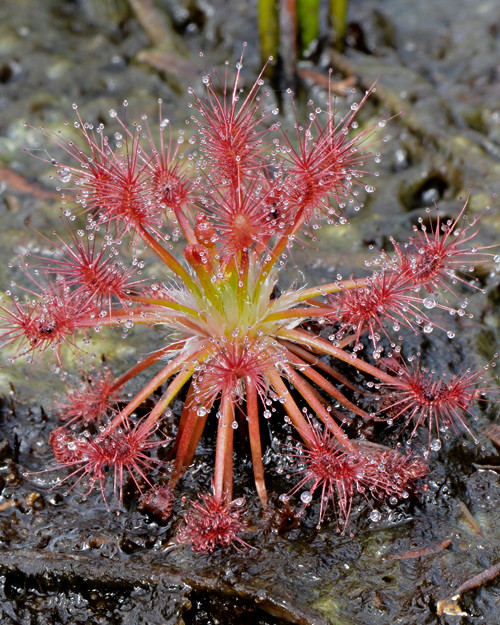
Drosera paleacea. Photo © Richard Nunn.
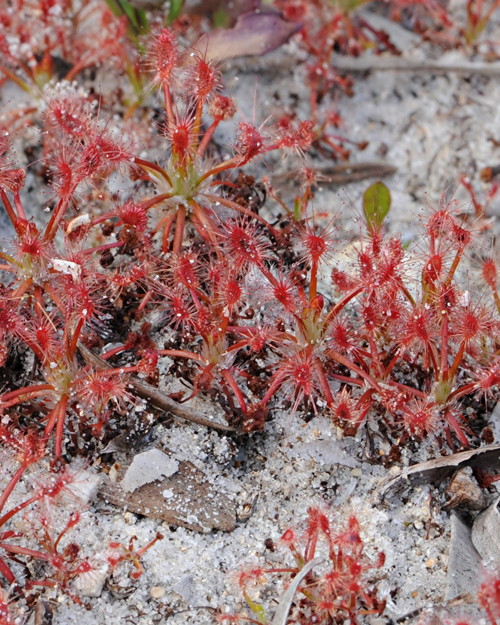
Drosera paleacea. Photo © Richard Nunn.
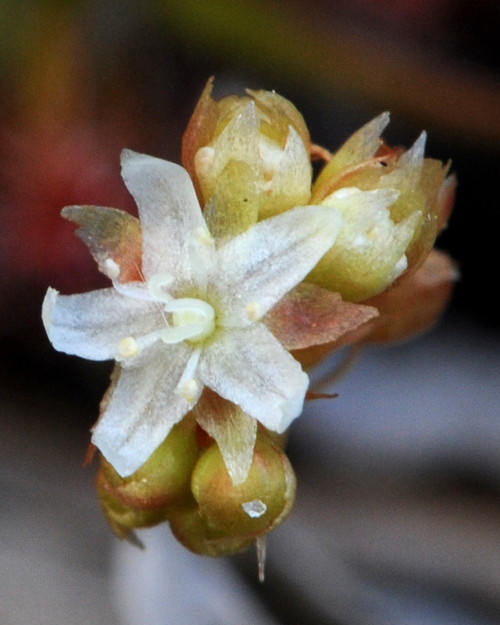
Drosera paleacea. Photo © Richard Nunn.
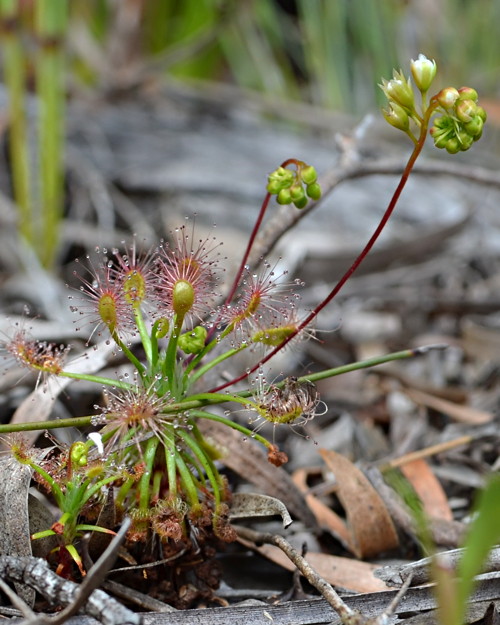
Drosera paleacea. Photo © Thilo Krueger.
Drosera patens Lowrie & Conran
The epithet patens is derived from the Latin patens (spreading), a reference to the spreading sepals of the fruiting calyx that surround the capsule, acting as a censer which holds the seeds. Drosera nitidula subsp. omissa is a synonym of Drosera patens.
Drosera patens is known from Western Australia, with records known from four locations spread over a 21 kilometre distance in the Perth metropolitan area, between Wanneroo and Beechboro, with Lake Gnangarra and Lake Jandabup locations between. Drosera patens is also known from the shores of Manaring Lake, in The Lakes district in the Darling Range ca. 44 kilometres east of the Beechboro location.
This species grows on the margins of swamps, lakes and winter-wet depressions in sandy soils.
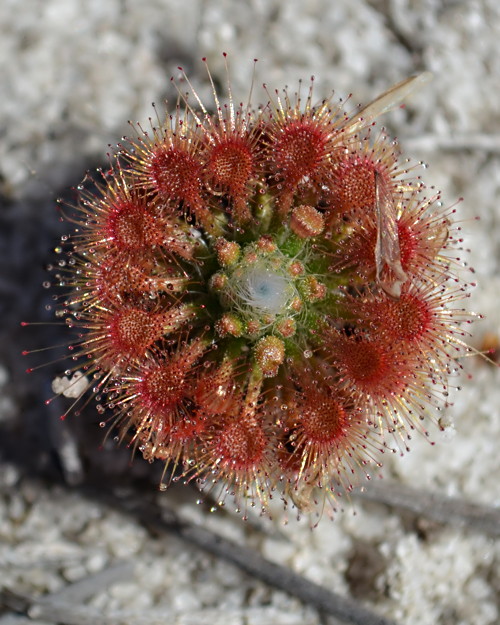
Drosera patens. Photo © Thilo Krueger.
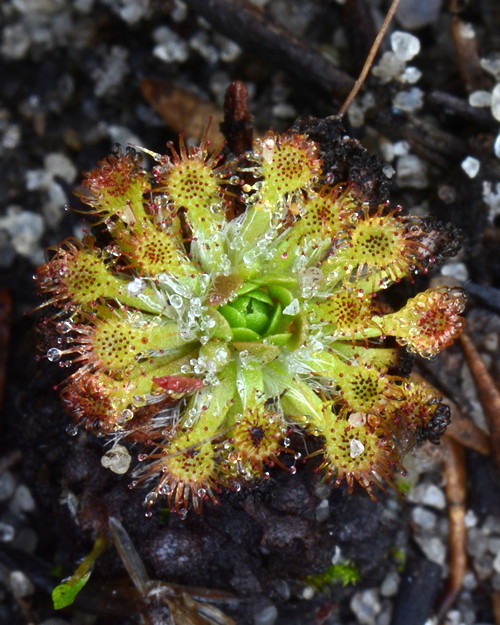
Drosera patens. Photo © Richard Nunn.
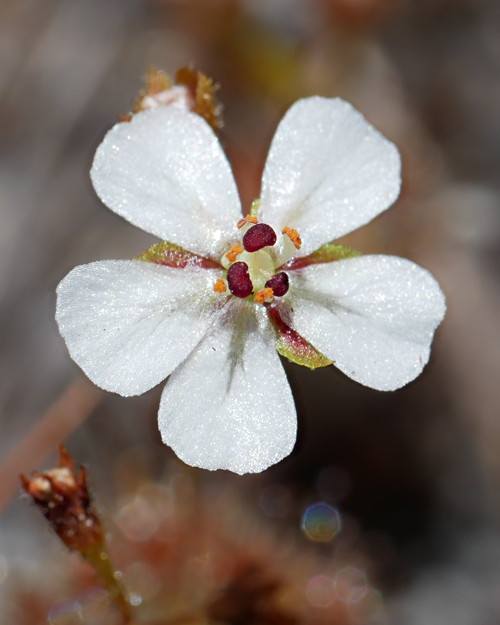
Drosera patens. Photo © Thilo Krueger.
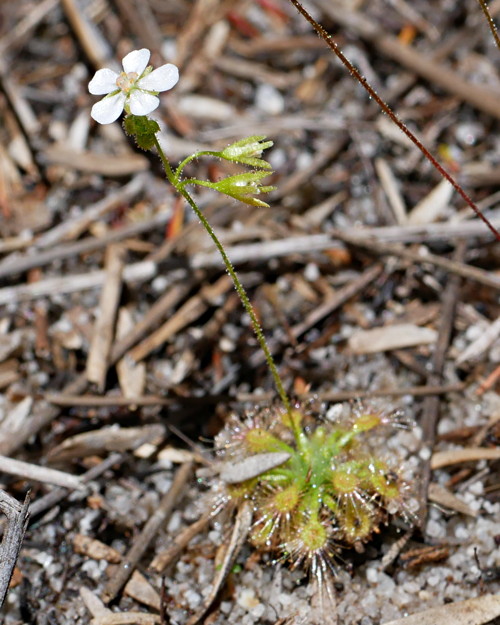
Drosera patens. Photo © Thilo Krueger.
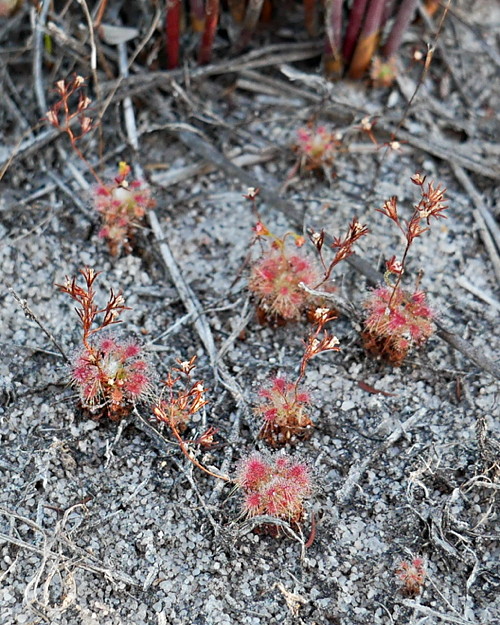
Drosera patens. Photo © Thilo Krueger.
Drosera pedicellaris Lowrie
The epithet pedicellaris is derived from the Latin pedicellus (pedicel) and the suffix -aris (provided with), in reference to the long, distinctive pedicels of this species.
Drosera pedicellaris is known from Western Australia, with records from two locations 7.4 kilometres apart in an area ca. 15 kilometres southwest of Three Springs. It has been found on Coalara Road, Badgingarra, and Cadda Road, Nambung.
It grows in deep, beige to white sandy soils, between and under low shrubs on heath land.
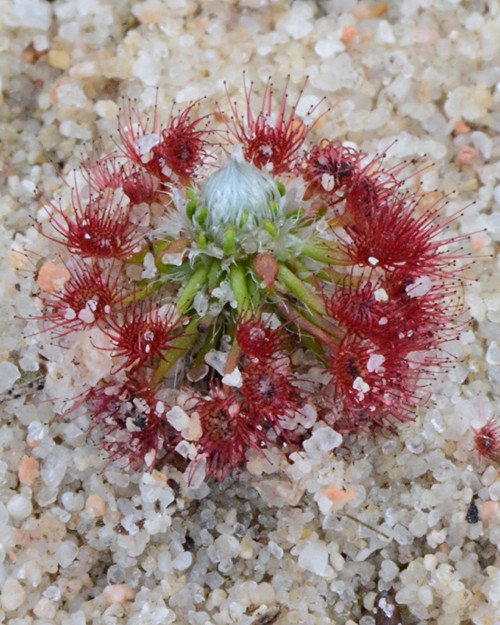
Drosera pedicellaris. Photo © Richard Nunn.
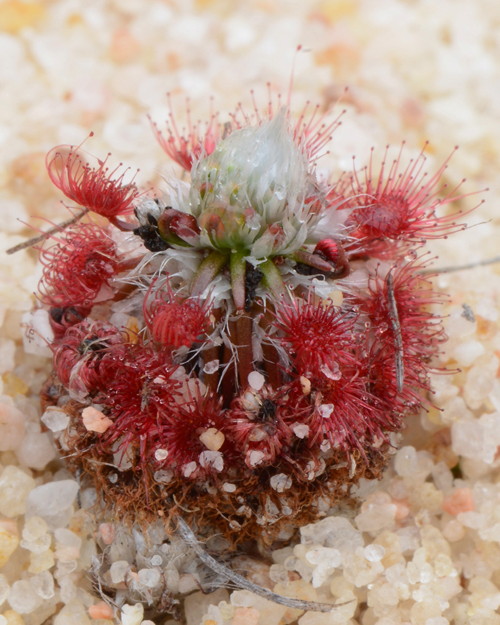
Drosera pedicellaris. Photo © Richard Nunn.
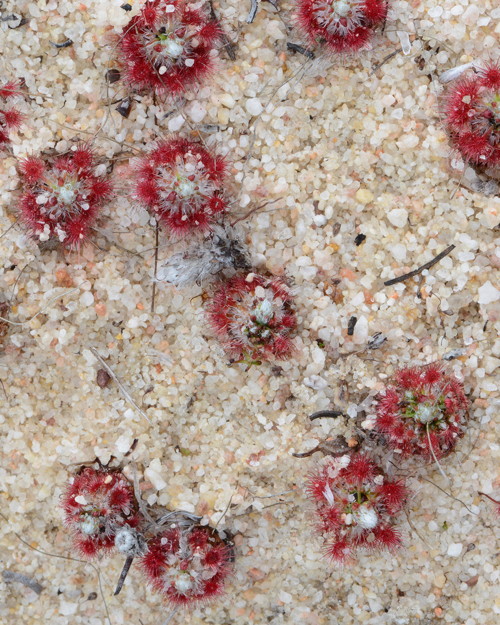
Drosera pedicellaris. Photo © Richard Nunn.
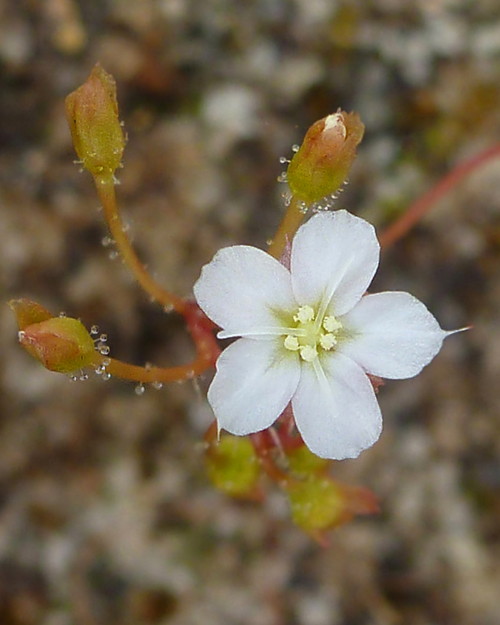
Drosera pedicellaris. Photo © Steve Fretwell.
Drosera platystigma Lehm.
Drosera platystigma is named from the Greek platys (broad, flat, wide) and stigma (stigma), in reference to the broad, slightly flattened, stigma.
Drosera platystigma is known from Western Australia, with records from Albany, Bannister, Busselton; Pinjarra, Stirling Range and Ravensthorpe.
It grows in clayey sand or laterite and loam soils in open heath, or in open areas in Jarrah forest.
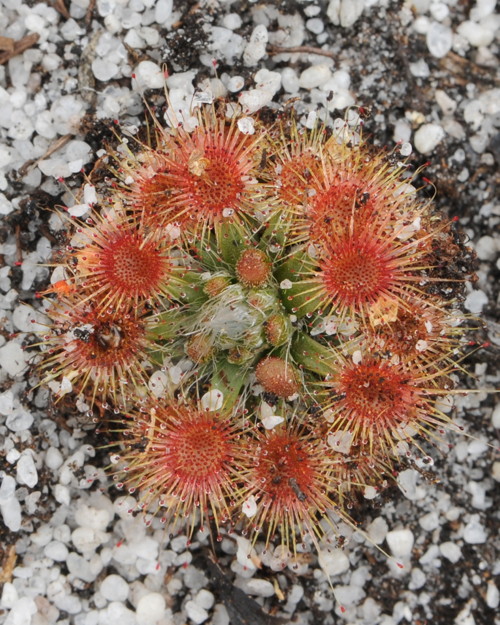
Drosera platystigma. Photo © Richard Nunn.
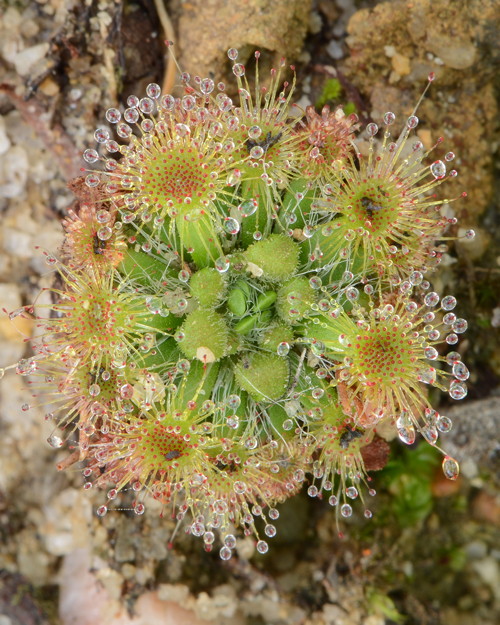
Drosera platystigma. Photo © Richard Nunn.
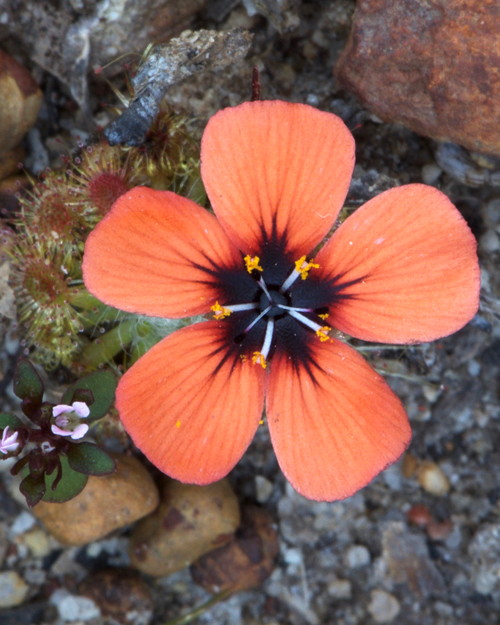
Drosera platystigma. Photo © Richard Nunn.
Drosera pulchella Lehm.
Drosera pulchella is named from the Latin pulchellus (beautiful and small), in reference to its pretty, diminutive form.
Drosera pulchella is known from Western Australia, with records from Perth, Augusta, Albany and Esperance.
It grows in sand, peaty sand, peat, laterite and loam soils on the margins of lakes, swamps and streams.
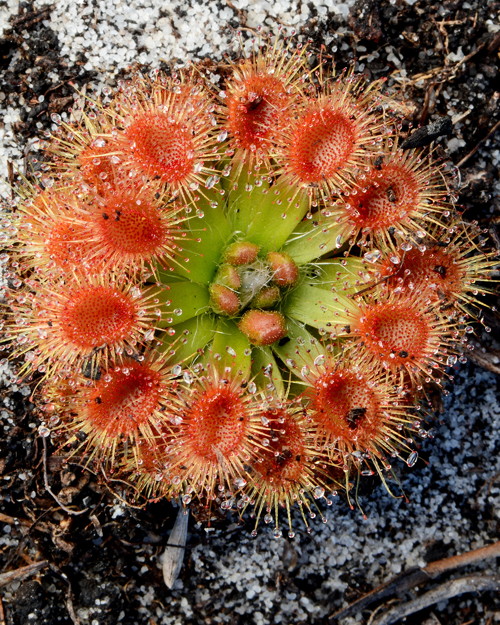
Drosera pulchella. Photo © Richard Nunn.
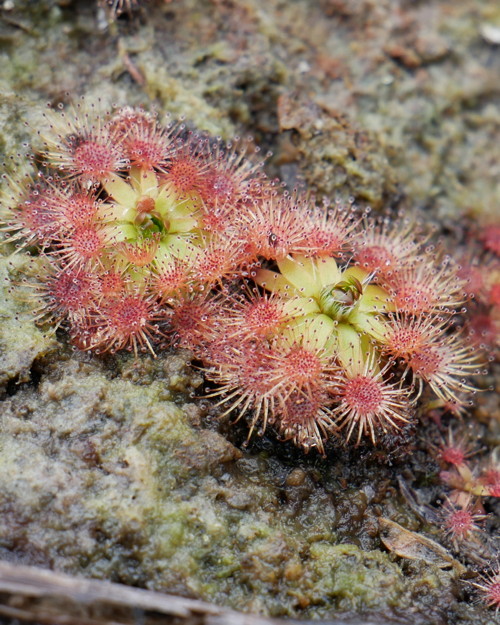
Drosera pulchella. Photo © Thilo Krueger.
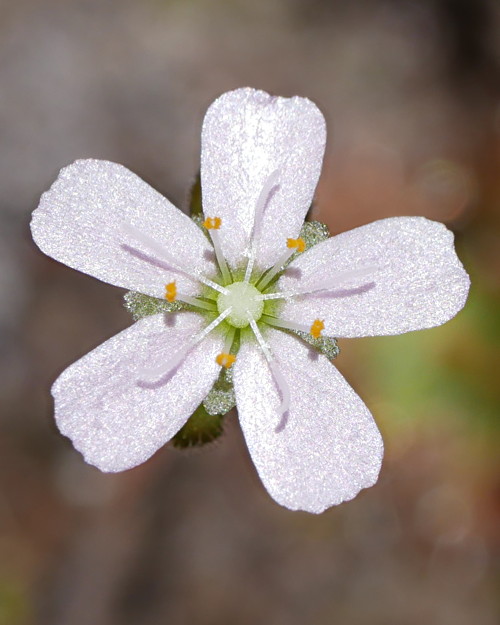
Drosera pulchella. Photo © Thilo Krueger.
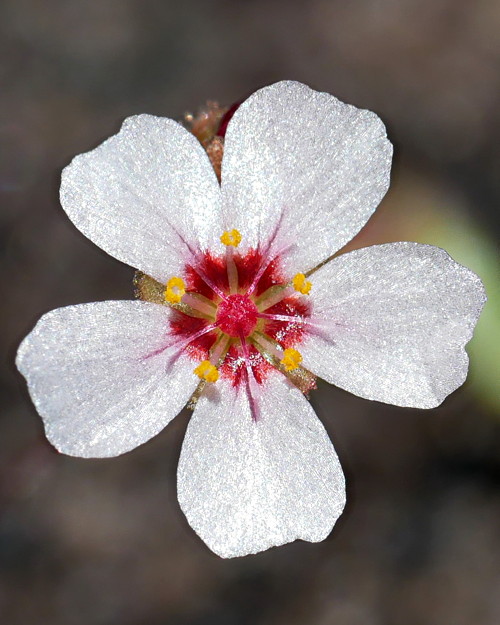
Drosera pulchella. Photo © Thilo Krueger.
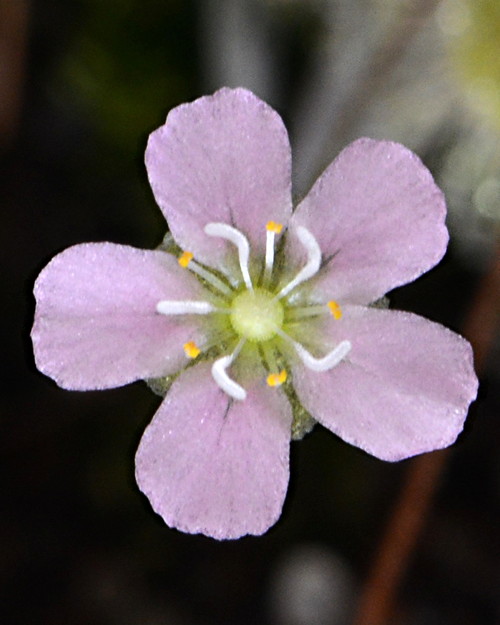
Drosera pulchella. Photo © Richard Nunn.
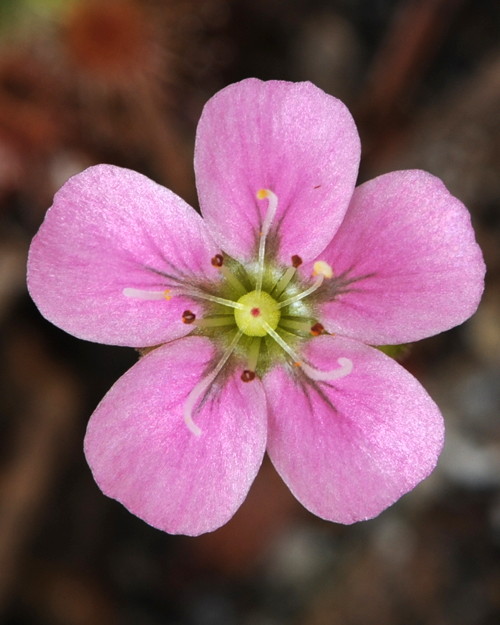
Drosera pulchella. Photo © Richard Nunn.
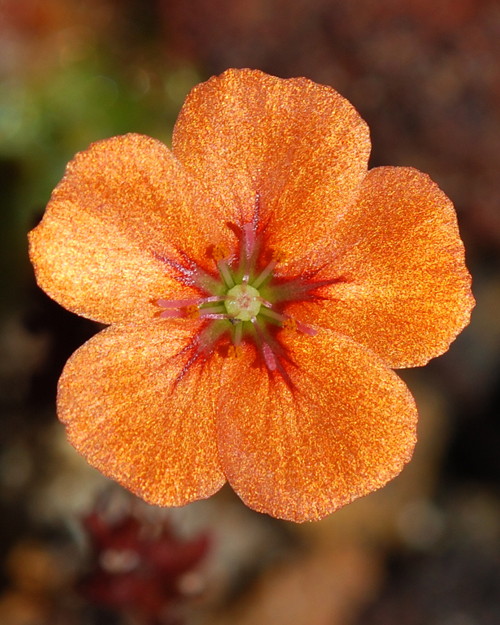
Drosera pulchella. Photo © Richard Nunn.
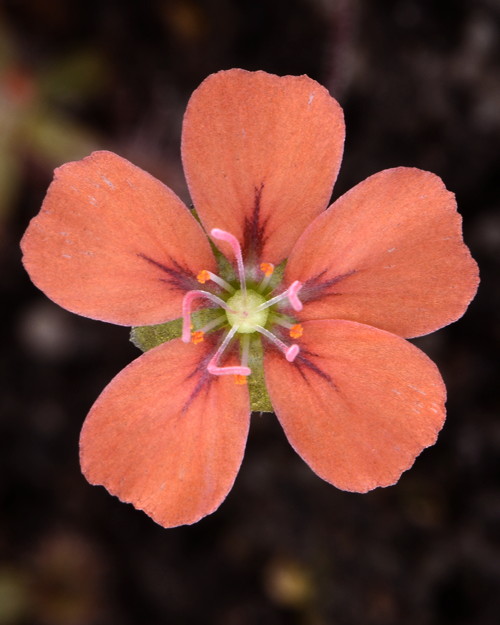
Drosera pulchella. Photo © Richard Nunn.
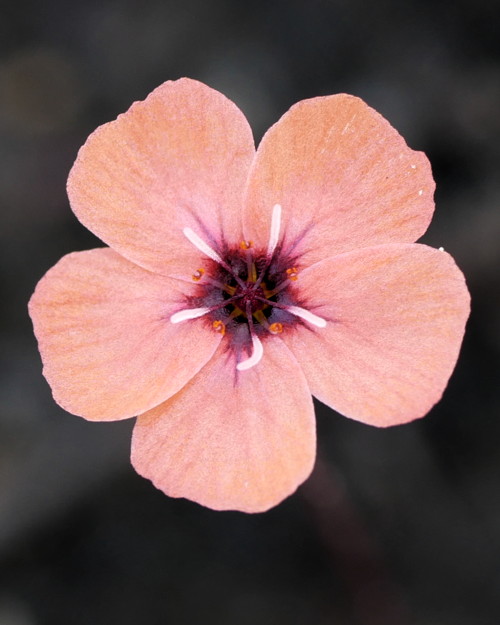
Drosera pulchella. Photo © Thilo Krueger.
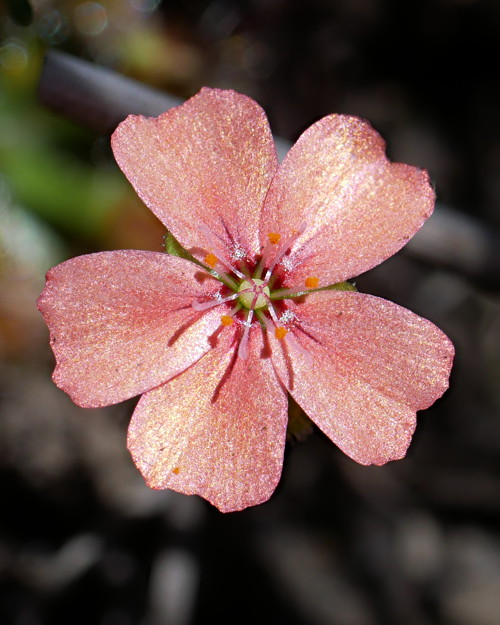
Drosera pulchella. Photo © Thilo Krueger.
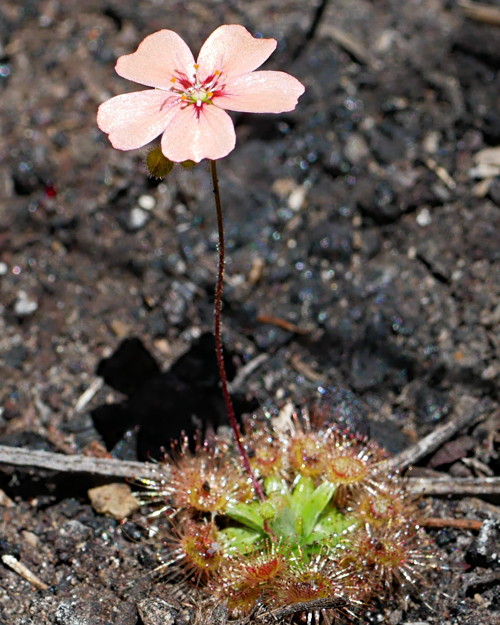
Drosera pulchella. Photo © Thilo Krueger.
